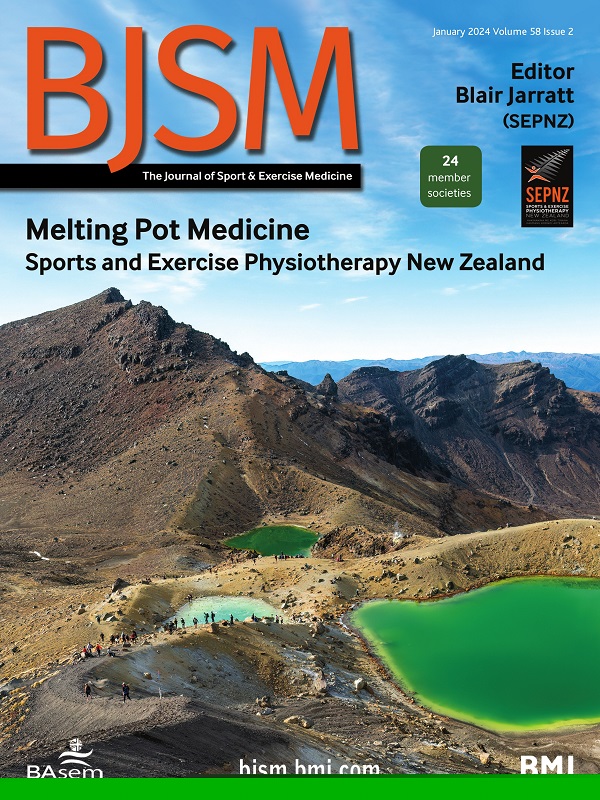CONCUSS randomised clinical trial of vergence/accommodative therapy for concussion-related symptomatic convergence insufficiency
IF 16.2
1区 医学
Q1 SPORT SCIENCES
引用次数: 0
Abstract
Objective The CONCUSS randomised clinical trial compared the effectiveness of immediate office-based vergence/accommodative therapy with movement (OBVAM) to delayed therapy for the treatment of concussion-related convergence insufficiency (CONC-CI) in participants 11–25 years old with persisting postconcussive symptoms 4–24 weeks post injury. Methods Symptomatic CONC-CI was diagnosed using clinical signs via near point of convergence (NPC) and positive fusional vergence (PFV) and symptoms via the Convergence Insufficiency Symptom Survey (CISS). Participants were randomised to immediate OBVAM (twice weekly for 6 weeks) or delayed OBVAM (starting 6 weeks after baseline enrolment). After 6 weeks (outcome time 1 assessment), the therapeutic outcomes of NPC, PFV and CISS were assessed and compared between the two groups. After the outcome time 1 assessment, the delayed group received twice-weekly OBVAM sessions for 8 weeks, while the immediate group received an additional 2 weeks of twice-weekly OBVAM sessions. The outcome time 2 assessment compared groups after each group received all 16 OBVAM sessions. Results In the immediate group, 46/52 (88%) were classified as successful or improved at the outcome time one assessment based on the primary outcome measure, a composite of NPC and PFV, compared with 4/52 (8%) in the delayed group (p<0.001). The mean NPC decreased (improved) by 7.9 cm in the immediate group and 1.8 cm in the delayed group (mean difference at outcome time 1 assessment: 5.1 cm (95% CI: 3.9 to 6.3; p<0.001)). The mean PFV increased (improved) by 17.5Δ in the immediate group and 2.5∆ in the delayed group (mean difference at outcome time 1 assessment: 15.0∆ (95% CI:11.7 to 18.3); p<0.001). At the outcome time 1 assessment, 41/52 (79%) of the participants in the immediate group had improved symptoms based on CISS scores ≤ preinjury scores or decreased by 10 points or more, compared with only 7/52 (13%) of participants from the delayed group (p<0.001). When comparing dosing in the immediate group, for 12 OBVAM sessions, 88% were classified as successful or improved using the composite measurement of NPC and PFV, which increased to 94% after 16 OBVAM sessions. For the outcome time 2 assessment, when both groups had received 16 OBVAM sessions, no significant difference was observed for NPC, PFV or CISS (p=1.0). Conclusion OBVAM therapy is effective in improving the NPC, PFV and symptoms in CONC-CI. Immediate initiation of OBVAM compared with delayed initiation shortens the period of symptoms experienced and fosters an earlier return to activities. Trial registration number clinicaltrials.gov identifier: [NCT05262361][1]. Data are available upon reasonable request. All de-identified data will be available upon request. [1]: /lookup/external-ref?link_type=CLINTRIALGOV&access_num=NCT05262361&atom=%2Fbjsports%2Fearly%2F2025%2F09%2F30%2Fbjsports-2025-109807.atomCONCUSS随机临床试验:收敛/调节治疗脑震荡相关症状性收敛功能不全
CONCUSS随机临床试验比较了在11-25岁、损伤后4-24周持续脑震荡症状的参与者中,立即基于办公室的融合/调节治疗(OBVAM)与延迟治疗治疗脑震荡相关融合功能不全(concc - ci)的有效性。方法采用近收敛点(NPC)和正收敛点(PFV)的临床体征和收敛不足症状调查(CISS)的症状诊断concc - ci症状。参与者被随机分配到立即OBVAM(每周两次,持续6周)或延迟OBVAM(在基线入组后6周开始)。6周后(结果时间1评估),对两组鼻咽癌、PFV和CISS的治疗结果进行评估和比较。结果时间1评估后,延迟组接受每周两次的OBVAM治疗,持续8周,而立即组接受额外的2周每周两次的OBVAM治疗。结果时间2评估比较各组接受全部16次OBVAM治疗后的结果。结果即时治疗组中,46/52(88%)患者在基于主要结局指标(NPC和PFV的综合指标)的一次评估中被评为成功或改善,而延迟治疗组为4/52 (8%)(p<0.001)。即时组鼻咽癌平均下降(改善)7.9 cm,延迟组下降(改善)1.8 cm(结果时间1评估时的平均差异:5.1 cm (95% CI: 3.9 ~ 6.3; p<0.001))。即时组平均PFV增加(改善)17.5Δ,延迟组平均PFV增加(改善)2.5(结果时间1评估时的平均差异:15.0∆(95% CI:11.7至18.3);p < 0.001)。在结果时间1评估时,41/52(79%)的即时组参与者根据CISS评分≤损伤前评分改善症状或减少10分或更多,而延迟组只有7/52(13%)的参与者(p<0.001)。当比较直接组的剂量时,在12个OBVAM疗程中,88%的人被归类为成功或改善,使用NPC和PFV的综合测量,在16个OBVAM疗程后,这一比例增加到94%。对于结果时间2的评估,当两组都接受了16次OBVAM治疗时,在NPC、PFV或CISS方面没有观察到显著差异(p=1.0)。结论OBVAM治疗可有效改善CONC-CI患者的鼻咽癌、PFV及症状。与延迟启动相比,立即启动OBVAM缩短了所经历的症状期,并促进更早地恢复活动。试验注册号clinicaltrials.gov识别码:[NCT05262361][1]。如有合理要求,可提供资料。如有要求,我们将提供所有未识别的数据。[1]: /查找/ external-ref ? link_type = CLINTRIALGOV&access_num = NCT05262361&atom = % 2 fbjsports % 2恐惧% 2 f2025 % 2 f09 % 2 + 30 % 2 fbjsports - 2025 - 109807. -原子
本文章由计算机程序翻译,如有差异,请以英文原文为准。
求助全文
约1分钟内获得全文
求助全文
来源期刊
CiteScore
27.10
自引率
4.90%
发文量
217
审稿时长
3-8 weeks
期刊介绍:
The British Journal of Sports Medicine (BJSM) is a dynamic platform that presents groundbreaking research, thought-provoking reviews, and meaningful discussions on sport and exercise medicine. Our focus encompasses various clinically-relevant aspects such as physiotherapy, physical therapy, and rehabilitation. With an aim to foster innovation, education, and knowledge translation, we strive to bridge the gap between research and practical implementation in the field. Our multi-media approach, including web, print, video, and audio resources, along with our active presence on social media, connects a global community of healthcare professionals dedicated to treating active individuals.

 求助内容:
求助内容: 应助结果提醒方式:
应助结果提醒方式:


